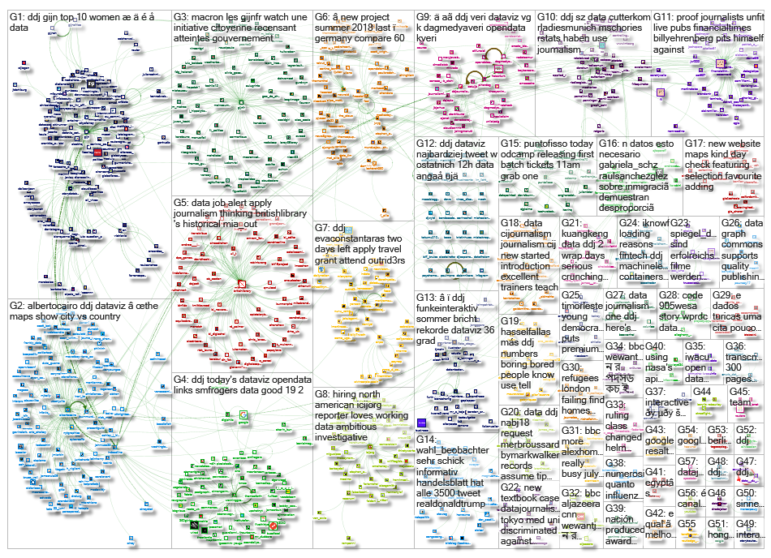What’s the global data journalism community tweeting about this week? Our NodeXL #ddj mapping from July 30 to Aug 5 finds practical advice from @junkcharts for conference presenters to showcase their graphics, @Google making data in data journalism pieces more searchable, @funkeinteraktiv displaying the ways Germany is breaking records this summer, @eldiarioes examining Spain’s immigration boom and author Colin Woodard breaking down America’s regional cultures in The New York Times.
Graphic Advice for Conference Presenters
One of the biggest sins in presenting graphics at a conference is to copy graphics directly from your published paper to slides without modifications. Statistician Kaiser Fung offers a few tips for conference presenters to make their graphics more impactful.
ALL OF THIS!! Especially the font size thing. Since most of us don't have giant screens of our own, try standing back from your monitor by about 5 feet and see if everything is still readable. If not, make everything bigger!https://t.co/sgyElJ8F7K
— Andrew Mercer (@awmercer) August 1, 2018
Record-breaking Summer
Summer 2018 is breaking records in Germany. Funke Interativ compares Germany’s summer temperatures, relative dryness and hours of sunshine for the past 60 years and shows how much these measurements have deviated from the mean in the past few months.
New ☀️⛱ project: how does the summer 2018 (germany) compare to the last 60 years. This time we did a static graphic with R + Illustrator, without .js (except for the building process). Quite refreshing to do a simple & small project. #dataviz #ddj https://t.co/DdtzLKKkz0 pic.twitter.com/3mTHLKBtj4
— David (@newreld) July 31, 2018
America’s “11 Regional Cultures”
Colin Woodard, author of American Nations: A History of the Eleven Rival Regional Cultures of North America writes that the divide in American politics isn’t between rural and urban populations but rather among regional cultures shaped by past colonialism. His opinion that former rival colonizers across the continent set patterns that are influencing modern politics and culture is drawing polarizing debates on Twitter.
Does geographical region have any effect independent of other economic, political, social, etc. variables? That’s a long-standing poli sci debate. Region falls in and out of fashion. This article is an interesting look at the “region matters” position. https://t.co/hgHZ6lUiVw
— John Coleman (@CLA_Coleman) August 6, 2018
Google Makes Data More Searchable
There is no reason why searching for datasets shouldn’t be as easy as searching for recipes, or jobs or movies. Google is working to surface more data from data journalism projects in its search results. News organizations can follow Google’s guidelines to have their data indexed.
Awesome @GoogleNewsInit collaboration facilitating discovery of public datasets by integrating data journalism—like @ProPublica Nonprofit Explorer's 990 tax return database—directly into @Google search results https://t.co/ua7hTQQWYJ pic.twitter.com/lWZyDJCIO4
— Anna Massoglia (@annalecta) August 1, 2018
Analyzing an Immigration Boom
Eldiario.es analyzes the effects of the 2002 immigration boom in Spain and found that immigration did not increase unemployment and it reduced the average age of inhabitants of areas with more immigrants.
1-La inmigración no amenaza el Estado del Bienestar
2-La inmigración no afecta a la tasa de paro
3-La inmigración rejuvenece la población
4-La inmigración salvará tu jubilación
Ante los bulos, DATOS (del INE en este caso).
Desgrana alto y claro @AnaOrdaz_ https://t.co/Qpha6zqSSl pic.twitter.com/tZMJzSYZah— José Ant Bautista (@JoseAntonio_BG) August 5, 2018
Empty Land Doesn’t Vote
The New York Times produced an interactive map of the 2016 US presidential election at the highest level of detail available: by voting precinct. The map, which revealed voting enclaves and voting patterns that are shaped by racial history or that followed city limits, drew a lot of criticism. Jonathan Crowe summarizes the big map debate here.
A good summary about the map debate of the past few days, with links: https://t.co/2Lho9hlcUp @mcwetboy #dataviz #infographics #ddj pic.twitter.com/kCST6mI2NK
— Alberto Cairo (@albertocairo) July 29, 2018
Civil Rights Violations in US Schools
Every year, the US Department of Education investigates thousands of school districts and colleges around the country for civil rights violations ranging from racial discrimination in school discipline to sexual violence. In June, ProPublica published the status of these cases over the past three years.
ProPublica has collected and published the status of civil rights cases filed with the Dept. of Ed's Office of Civil Rights between 1/20/2015 and 5/2/2018. Interesting data! https://t.co/WNluHYPxhh
— Sarah Wayland (@ParentGuiding) August 4, 2018
Perception in Data Visualization
Northwestern University professor Steve Franconeri talks about the different ways our human visual system extracts spatial relationships between objects — object recognition, feature distributions, comparisons — and how these affect our perception of data visualization. For more videos from the OpenVis Conference, check out their YouTube channel.
If you're into dataviz don't miss out watching this talk: Thinking with Data Visualizations, Fast and Slow by @SteveFranconeri https://t.co/l9b07W4E2l pic.twitter.com/9HPycixWNj
— Walter Rafelsberger (@walterra) August 2, 2018
Data Journalism Workshop in Timor-Leste
The Southeast Asian Press Alliance recently conducted a two-day training on data journalism in East Timor’s capital, Dili. Journalists and media practitioners learned about collecting and cleaning data, analysis and presentation, trends and data visualization tools, as well as journalist safety and digital security.
#DataViz News: [Timor-Leste] A young democracy puts premium on media training – SEAPA https://t.co/ilkYwSau6m, see more https://t.co/6oyvjUiMZH
— Jen Stirrup (@jenstirrup) August 1, 2018
Data Visualization Book
Kieran Healy, associate professor of sociology at Duke University, has tried to introduce the ideas and methods of data visualization in a sensible, comprehensible, reproducible way in his soon-to-be-released Data Visualization: A Practical Introduction book.
Some #dataviz swag: @PrincetonUPress made an awesome 11×17 sixteen month calendar to go with the book. You can pick one up at #ASA2018 next week! https://t.co/NNfOGc4f5l pic.twitter.com/S0OVAdjw23
— Kieran Healy (@kjhealy) August 3, 2018
Thanks, once again, to Marc Smith of Connected Action for gathering the links and graphing them.
 Eunice Au is GIJN’s program coordinator. Previously, she was a Malaysia correspondent for Singapore’s The Straits Times, and a journalist at the New Straits Times. She has also written for The Sun, Malaysian Today and Madam Chair.
Eunice Au is GIJN’s program coordinator. Previously, she was a Malaysia correspondent for Singapore’s The Straits Times, and a journalist at the New Straits Times. She has also written for The Sun, Malaysian Today and Madam Chair.

